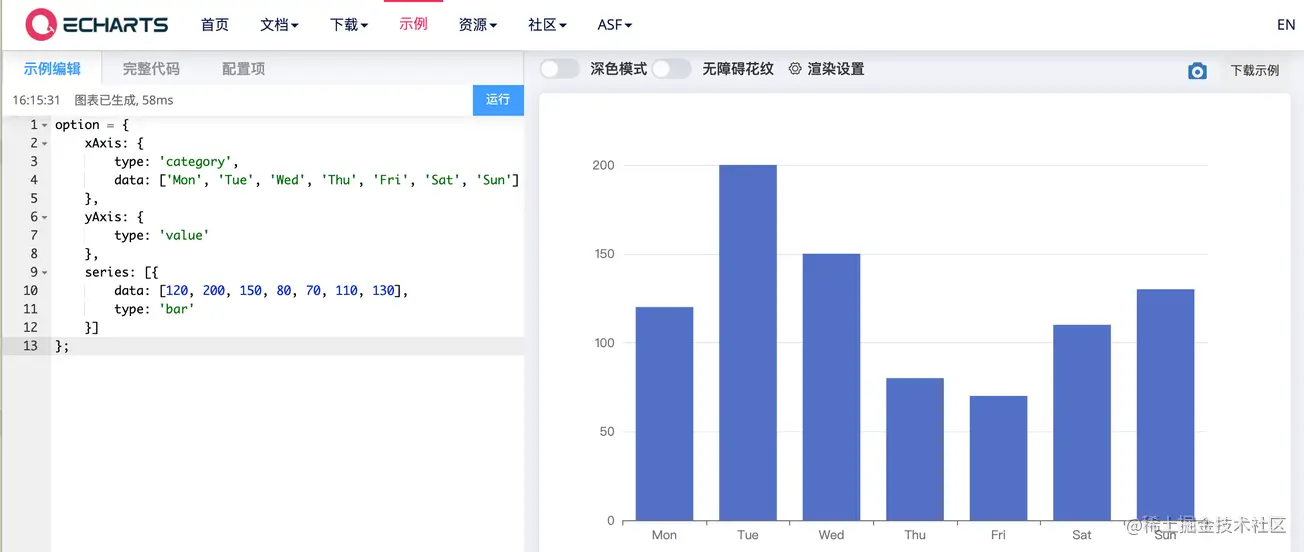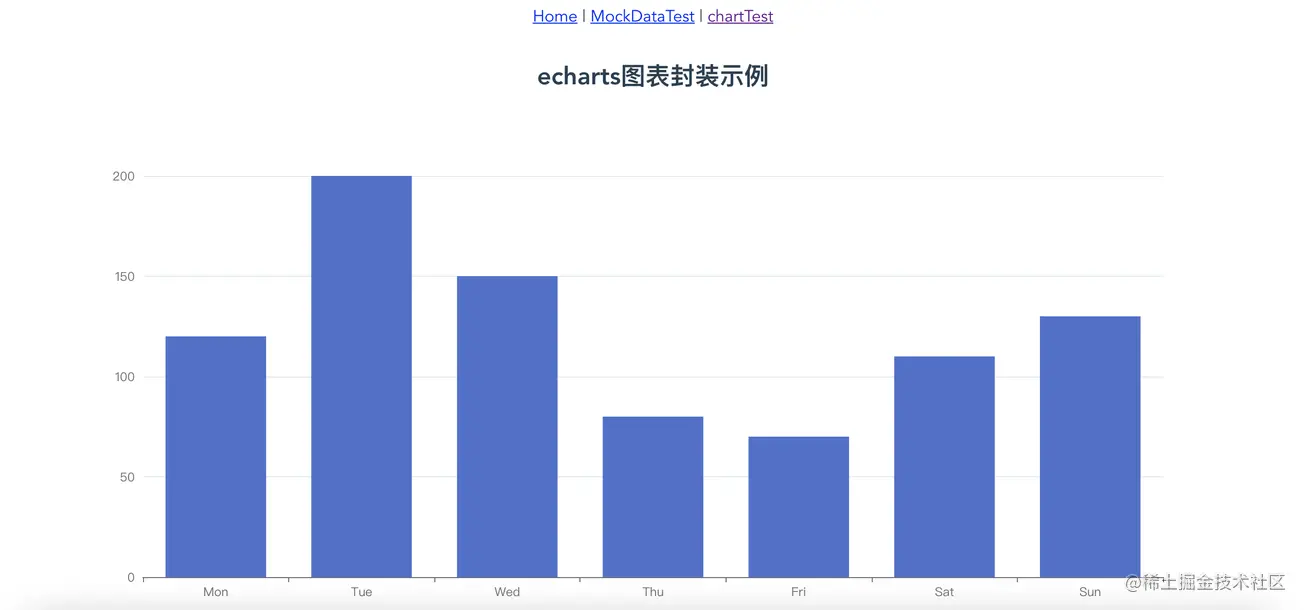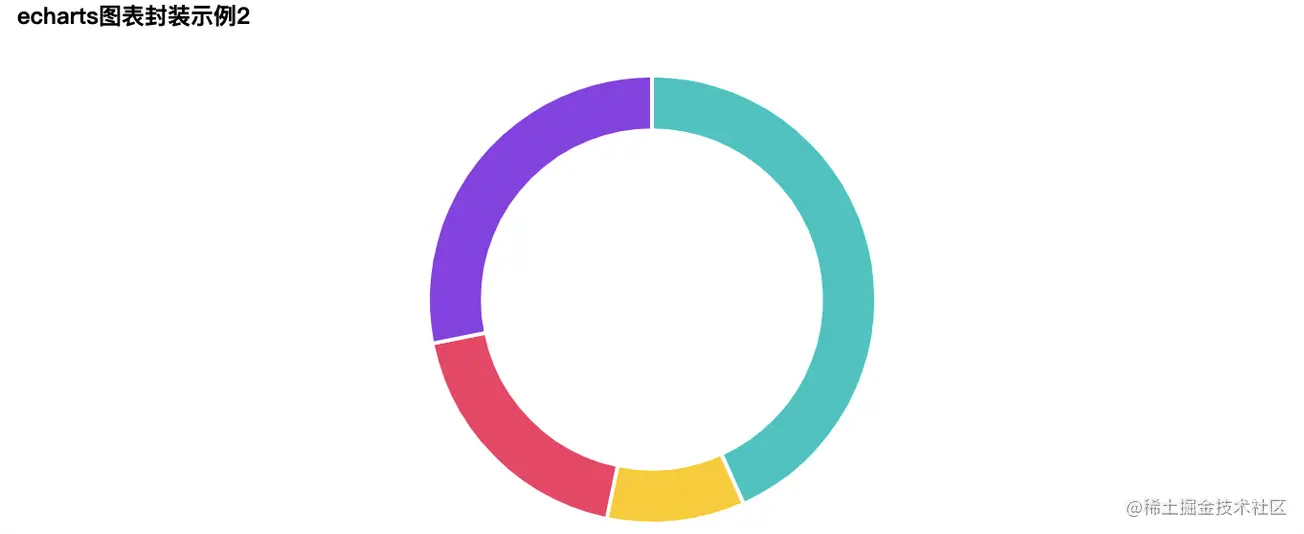vue專案怎麼優雅的封裝echarts?方法介紹

場景
- 1、Echarts使用時,都需要寫一堆的option,如果每個圖表都要寫一個,一個檔案裡面的程式碼量是很大的
- 2、不方便複用
需求
- 1、方便複用
- 2、展示類的圖表,資料與業務、樣式分離,只傳資料就行
- 3、專案裡需要用到的圖表會有多個,實現少程式碼自動化匯入,不需要一個個import
- 4、本人圖表用在大屏資料視覺化的情況比較多,採用的是等比縮放的方式,所以圖表也能根據介面縮放自動縮放,不需要手動呼叫。【相關推薦:】
- 5、圖表可設定
程式碼總覽
涉及的檔案如下(具體參考程式碼):
|-- src
|-- components
|-- chart
|-- index.vue // 圖表單檔案元件,供介面呼叫
|-- index.js // 實現自動化匯入options裡的圖表option
|-- options // 存放各種圖表的option
|-- bar // 隨便一例子
|-- index.js
|-- views
|-- chartTest // 範例所在
|-- index.vue
|-- index.scss
|-- index.js
|-- main.js // 全域性引入echarts圖表實現
components--chart--index.vue
這裡定義了一個名為ChartView 的元件,開放了4個可設定的屬性:寬度width,高度height, 是否自動調整大小autoResize(預設是), 圖表的設定chartOption。
這裡預設用Canvas 渲染圖表了,也可以用SVG的,自選吧
具體程式碼如下
<template>
<div class="chart">
<div ref="chart" :style="{ height: height, width: width }" />
</div>
</template>
<script>
// 引入 echarts 核心模組,核心模組提供了 echarts 使用必須要的介面。
import * as echarts from 'echarts/core'
// 引入柱狀圖圖表,圖表字尾都為 Chart
import {
BarChart
} from 'echarts/charts'
// 引入提示框,標題,直角座標系元件,元件字尾都為 Component
import {
TitleComponent,
TooltipComponent,
GridComponent
} from 'echarts/components'
// 引入 Canvas 渲染器,注意引入 CanvasRenderer 或者 SVGRenderer 是必須的一步
import {
CanvasRenderer
} from 'echarts/renderers'
// 註冊必須的元件
echarts.use(
[TitleComponent, TooltipComponent, GridComponent, BarChart, CanvasRenderer]
)
export default {
name: 'ChartView',
props: {
width: {
type: String,
default: '100%'
},
height: {
type: String,
default: '350px'
},
autoResize: {
type: Boolean,
default: true
},
chartOption: {
type: Object,
required: true
},
type: {
type: String,
default: 'canvas'
}
},
data() {
return {
chart: null
}
},
watch: {
chartOption: {
deep: true,
handler(newVal) {
this.setOptions(newVal)
}
}
},
mounted() {
this.initChart()
if (this.autoResize) {
window.addEventListener('resize', this.resizeHandler)
}
},
beforeDestroy() {
if (!this.chart) {
return
}
if (this.autoResize) {
window.removeEventListener('resize', this.resizeHandler)
}
this.chart.dispose()
this.chart = null
},
methods: {
resizeHandler() {
this.chart.resize()
},
initChart() {
this.chart = echarts.init(this.$refs.chart, '', {
renderer: this.type
})
this.chart.setOption(this.chartOption)
this.chart.on('click', this.handleClick)
},
handleClick(params) {
this.$emit('click', params)
},
setOptions(option) {
this.clearChart()
this.resizeHandler()
if (this.chart) {
this.chart.setOption(option)
}
},
refresh() {
this.setOptions(this.chartOption)
},
clearChart() {
this.chart && this.chart.clear()
}
}
}
</script>components--chart--index.js
這裡主要利用require.context,把options裡面定義的圖表遍歷匯入,這樣就不需要在程式碼裡一個個import了,特別是圖表多的時候。
const modulesFiles = require.context('./options', true, /index.js$/)
let modules = {}
modulesFiles.keys().forEach(item => {
modules = Object.assign({}, modules, modulesFiles(item).default)
})
export default modulescomponents--chart--options
這裡展示下如何封裝自己想要的圖表
在Echarts官方範例(https://echarts.apache.org/examples/zh/index.html)上隨便選了個範例

在options下新建一個bar目錄,bar目錄下新建一個index.js檔案。(個人習慣而已,喜歡每個圖表都獨立資料夾存放。不喜歡這種方式的,可以不放目錄,直接js檔案,但是components--chart--index.js要對應修改下)
直接複製範例的option程式碼
index.js具體程式碼如下
const testBar = (data) => {
const defaultConfig = {
xAxis: {
type: 'category',
data: ['Mon', 'Tue', 'Wed', 'Thu', 'Fri', 'Sat', 'Sun']
},
yAxis: {
type: 'value'
},
series: [{
data: [120, 200, 150, 80, 70, 110, 130],
type: 'bar'
}]
}
const opt = Object.assign({}, defaultConfig)
return opt
}
export default {
testBar
}testBar方法是可以傳參的,具體使用的時候,圖表所需要設定的屬性,如:data資料、圖表顏色......等都可以作為引數傳。
main.js
這裡全域性引入下封裝的Echarts元件,方便介面呼叫。(至於單個參照的方式,就不必多說了)
具體程式碼如下:
import eChartFn from '@/components/chart/index.js' import ChartPanel from '@/components/chart/index.vue' Vue.component(ChartPanel.name, ChartPanel) Vue.prototype.$eChartFn = eChartFn
chartTest
這裡展示下如何呼叫封裝的bar圖表,主要程式碼如下
index.vue
<chart-view class="chart-content" :chart-option="chartOpt" :auto-resize="true" height="100%" />
index.js
export default {
name: 'chartTestView',
data() {
return {
chartOpt: {}
}
},
mounted() {},
created() {
this.chartOpt = this.$eChartFn.testBar()
},
methods: {
},
watch: {}
}效果如下

可以嘗試拖動瀏覽器的大小,可以看到,圖表也是隨著瀏覽器的拖動自動縮放的。
程式碼
按程式碼總覽的目錄去程式碼裡找著看就行了。
https://github.com/liyoro/vue-skill
總結
Echarts用到的各種圖表,基本上都可以在Echarts官方範例和Echarts視覺化作品分享上找到,特別是Echarts視覺化作品分享,做專案的時候,可以去參考。
以上,封裝了chart元件,按照上述方式,把圖表的option設定和相關處理都放options資料夾下面,呼叫圖表時傳對應的option,也就幾行程式碼的事情,算是比較方便了。
chart元件很方便複用的,直接就可以使用了。
補充
評論裡說想動態修改option裡面的屬性,稍微做了個例子,動態修改pie圖表的data和color屬性,這個是直接生產就可以使用的例子了,直接參考程式碼就行了,不詳細說了。想修改什麼屬性,直接傳參就行。傳具體引數可以,想修改的屬性多了就把引數封裝成一個json傳也可以。懂得在封裝的option裡面靈活使用就行。
以下是新增的參考程式碼
|-- src
|-- components
|-- chart
|-- options // 存放各種圖表的option
|-- pie // pie例子
|-- index.js
|-- views
|-- chartTest // 範例所在
|-- index.vue
|-- index.scss
|-- index.js程式碼使用都是直接一行呼叫的
this.chartOpt2 = this.$eChartFn.getPieChart([100, 23, 43, 65], ['#36CBCB', '#FAD337', '#F2637B', '#975FE4'])
效果如下:

補充2:圖表高亮輪詢,dispatchAction使用
效果圖

使用方法
加上:play-highlight="true"屬性就行
<chart-view class="chart-content" :chart-option="chartOpt2" :auto-resize="true" :play-highlight="true" height="100%" />
主要實現的程式碼在如下檔案的playHighlightAction方法裡面,參考的echarts 餅圖呼叫高亮範例 dispatchAction實現的。只是簡單的高亮輪詢,具體各種實現就自己看檔案調樣式了。
|-- src
|-- components
|-- chart
|-- index.js // 實現自動化匯入options裡的圖表option(學習視訊分享:、)
以上就是vue專案怎麼優雅的封裝echarts?方法介紹的詳細內容,更多請關注TW511.COM其它相關文章!